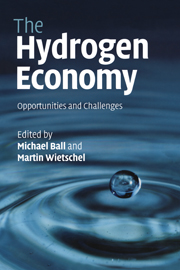Book contents
- Frontmatter
- Contents
- List of main contributors
- Preface
- Acknowledgements
- List of abbreviations
- 1 Scope of the book
- 2 Why hydrogen?
- 3 Non-renewable energy resources: fossil fuels – supply and future availability
- 4 Non-renewable energy resources: nuclear fuels
- 5 Assessment of the potentials for renewable energy sources
- 6 Carbon capture and storage
- 7 Energy-chain analysis of hydrogen and its competing alternative fuels for transport
- 8 Hydrogen today
- 9 Fundamental properties of hydrogen
- 10 Hydrogen production
- 11 Hydrogen storage
- 12 Hydrogen distribution
- 13 Key role of fuel cells
- 14 Hydrogen-infrastructure build-up in Europe
- 15 Building a hydrogen infrastructure in the USA
- 16 Hydrogen and the electricity sector
- 17 Hydrogen corridors
- 18 Macroeconomic impacts of hydrogen
- 19 Sustainable transport visions: the role of hydrogen and fuel-cell vehicle technologies
- 20 Energy-efficient solutions needed – paving the way for hydrogen
- 21 The future of hydrogen – opportunities and challenges
- Further reading
- Index
- References
4 - Non-renewable energy resources: nuclear fuels
Published online by Cambridge University Press: 22 January 2010
- Frontmatter
- Contents
- List of main contributors
- Preface
- Acknowledgements
- List of abbreviations
- 1 Scope of the book
- 2 Why hydrogen?
- 3 Non-renewable energy resources: fossil fuels – supply and future availability
- 4 Non-renewable energy resources: nuclear fuels
- 5 Assessment of the potentials for renewable energy sources
- 6 Carbon capture and storage
- 7 Energy-chain analysis of hydrogen and its competing alternative fuels for transport
- 8 Hydrogen today
- 9 Fundamental properties of hydrogen
- 10 Hydrogen production
- 11 Hydrogen storage
- 12 Hydrogen distribution
- 13 Key role of fuel cells
- 14 Hydrogen-infrastructure build-up in Europe
- 15 Building a hydrogen infrastructure in the USA
- 16 Hydrogen and the electricity sector
- 17 Hydrogen corridors
- 18 Macroeconomic impacts of hydrogen
- 19 Sustainable transport visions: the role of hydrogen and fuel-cell vehicle technologies
- 20 Energy-efficient solutions needed – paving the way for hydrogen
- 21 The future of hydrogen – opportunities and challenges
- Further reading
- Index
- References
Summary
Nuclear fuels
Nuclear power today and outlook until 2030
Civilian use of nuclear power started with the opening of the first nuclear reactor in 1957 in the United Kingdom, generating approximately 50 MWel in its first year. This picture has changed considerably since the beginning of the 1970s. In 2006, nuclear power contributed around 2700 TWh to 16% of global electricity generation (6% of primary energy use) (WNA, 2007). Worldwide, some 440 nuclear power plants are in operation in 30 countries, using the energy released by nuclear fission of the natural uranium radionuclide 235U. (All commercial nuclear plants today use uranium as fuel (Olah et al., 2006).) The total installed nuclear-generation capacity amounts to around 370 GWel.
Three countries, namely the USA (104 plants), France (59 plants) and Japan, account for approximately 58% of the worldwide generation capacity, followed by Germany and the Russian Federation. These three countries also dominated the historical development of nuclear power expansion (see Fig. 4.1). The three countries with the highest nuclear energy share in their electricity mix today are France, with around 75%, followed by Lithuania, with 70%, and Slovakia, with 55%. While nuclear power contributes some 20% to power generation in the United States, the share in the EU25 is around 36%.
The historic growth of nuclear power can be divided into three broad periods: early growth (1957–1973), major expansion (1973–1990), and slow growth (1990 until today) (NEA/IAEA, 2006a).
- Type
- Chapter
- Information
- The Hydrogen EconomyOpportunities and Challenges, pp. 115 - 134Publisher: Cambridge University PressPrint publication year: 2009



